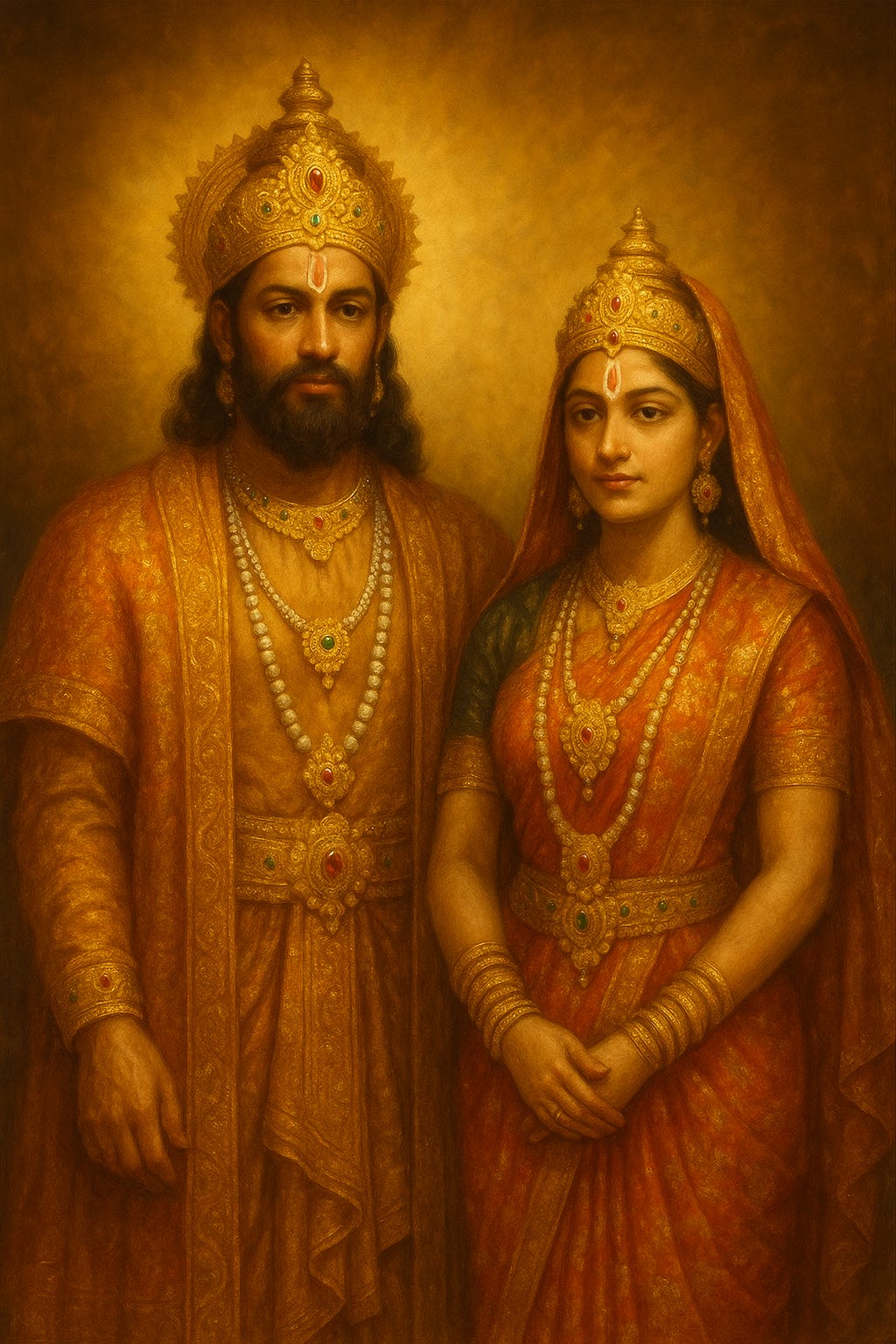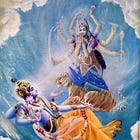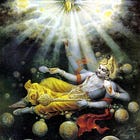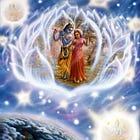The creation of the first Manu
After manifesting all different material qualities and branches of knowledge, Brahma lamented that despite all this work, the population of the universe was still not increasing. Then Manu appea
After manifesting all different material qualities and branches of knowledge, Brahma lamented that despite all this work, the population of the universe was still not increasing. By himself, Brahma can only produce one being at a time through meditation. For the population to increase, He depends on His sons generating population through sexual union.
As he contemplated, two forms were generated from his body, one male and another female. The male was Svāyambhuva Manu, the first in the sequence of 14 Manus, and the female was his wife Śatarūpā. This led to the start of the first Manvantara.
There are 14 Manus in a day of Brahma, of which Svāyambhuva Manu is the first. Svāyambhuva Manu is generated directly from Brahma, while the other Manus appear as descendants of Svāyambhuva Manu or of the other sons of Brahma.
The reign of Svāyambhuva Manu started close to the beginning of the current day of Brahma, 1.973 billion years ago, according to the Puranic chronology.
There are two ways of calculating the dates given in the Vedas. One is to just add the numbers the way they are mentioned in the scriptures. This results in what can be called Puranic dates, dates according to time in Bhu-Mandala that we can use to understand the chronology of the different events mentioned in the scriptures, according to the day of Brahma, the different Manvantaras, and so on.
Another way is to calculate the dates according to solar years on our planet. This calculation is useful when we want to relate dates mentioned in the Puranas with dates mentioned in scientific studies. This is done by taking into consideration Sridhara Swami’s factor of two.
For example, the date for the creation of the solar system according to years in Bhu-mandala is 2.281 billion years ago, which is much less than the 4.567 billion years given by modern studies. However, when we convert the date to solar years, obtaining thus the date on our planet, according to Sridhara Swami’s factor of two, we get 4.562 billion years, which is quite close to modern studies.
Similarly, when we calculate the date for the beginning of the universe, we come to 6.9095 billion years in terms of years in Bhu-mandala (starting from the end of the last day of Brahma, when the previous universe was completely destroyed). When we convert to years on our planet, however, we come to 13.819 billion years, which is extraordinarily close to the 13.801 billion years given in the latest scientific studies. It seems that after two centuries of studies, modern scientists are coming quite close to the correct dates for the creation of the universe and the solar system given in the Vedas. As Prabhupada explains, experimental knowledge is also a way to obtain knowledge, but it is a very slow and painful process. If we just accept the knowledge from the Vedas, we save a lot of time.
Back to Manu, when Brahma saw that despite creating several sons, there was not a great increase in population, he started considering how the population of the universe could be increased. While he was thus contemplating, the first Manu, as well as his wife, were generated from his body.
While he was thus absorbed in contemplation and was observing the supernatural power, two other forms were generated from his body. They are still celebrated as the body of Brahmā.
The two newly separated bodies united in a sexual relationship. Out of them, the one who had the male form became known as the Manu named Svāyambhuva, and the woman became known as Śatarūpā, the queen of the great soul Manu. Thereafter, by sex indulgence, they gradually increased generations of population one after another.” (SB 3.12.54-55)
Svāyambhuva Manu and Śatarūpā had five children: two sons, Priyavrata and Uttānapāda, and three daughters, Ākūti, Devahūti, and Prasūti.
Ākūti was given in marriage to the sage Ruci (another of his sons), Devahūti, to the sage Kardama, and Prasūti, to Dakṣa. These three couples had many daughters who were given in marriage to the other sons of Brahma and other sages. From these couples, the universe was gradually populated.
Svāyambhuva Manu is a great devotee of the Lord, considered one of the 12 authorities in Vedic knowledge in our universe. Thus, Manu received from Brahma the mission of begetting qualified children with the assistance of his wife, and in this way bringing forth generations of living entities that could be trained in the practice of devotional service.
Often, we think that the purpose of life is just economic development and the realization of personal ambitions, but the real goal is to improve our spiritual understanding and gradually reconnect ourselves with our eternal nature as spirit souls. The whole universe is created with this ultimate objective, starting with the advent of Svāyambhuva Manu.
However, when Manu was blessed to start his activities, he noticed that the earth was submerged in the waters of the Garbhodaka ocean. The word used here for the earth is “mahīm”, which indicates the great earth, Bhu-Mandala. This becomes clear in SB 5.20.45, where Prabhupada translates the word as “the earthly planets” in the context of an explanation of Vedic cosmology.
Bhu-Mandala forms the intermediate planetary system, which is exactly the place Manu is supposed to reign. With Bhu-Mandala submerged, there was no way for Manu to perform his activities.
After hearing about the problem, Brahma started thinking about how Bhu-Mandala could be lifted. As he thought, a small form of a boar came out of his nostril. This boar quickly grew in size, assuming a gigantic form. This boar was no one else than Lord Vishnu Himself, in his form of Varāhadeva, Who entered into the ocean and raised Bhu-Mandala back into its proper place, allowing Svāyambhuva Manu to start his work.
Throughout his books, Prabhupada repeatedly makes the point that although Krsna doesn’t have a material form, He does have a form (spiritual in nature), including transcendental spiritual senses. Just like we have the propensity to execute activities, Krsna also has the propensity to execute activities. The difference is that while we perform activities under the spell of the three material modes, Krsna performs transcendental pastimes. According to the pastimes he wants to perform, Krsna assumes an appropriate form. Hiraṇyakaśipu had blessings from Lord Brahma that he would not be killed by a human nor by an animal, and therefore Krsna assumed a form that is half-man, half-lion. Similarly, when Krsna desired to lift Bhu-Mandala, which had fallen into the Garbhodaka ocean, he assumed the form of a transcendental hog to rescue Bhu-Mandala from inside the water.
As Prabhupada mentions in his purport to 3.13.44: “Ordinarily the body of a hog is considered impure, but one should not consider that the hog incarnation assumed by the Lord is also impure. That form of the Lord is the personified Vedas and is transcendental.”
Read also:






Hare Krishna Prabhu ji 🙏 very informative article about the timeline of creation of universe . But unfortunately Prabhu ji I didn't get the sridhar swami's factor of 2 ? What it is and how does it work?